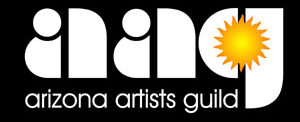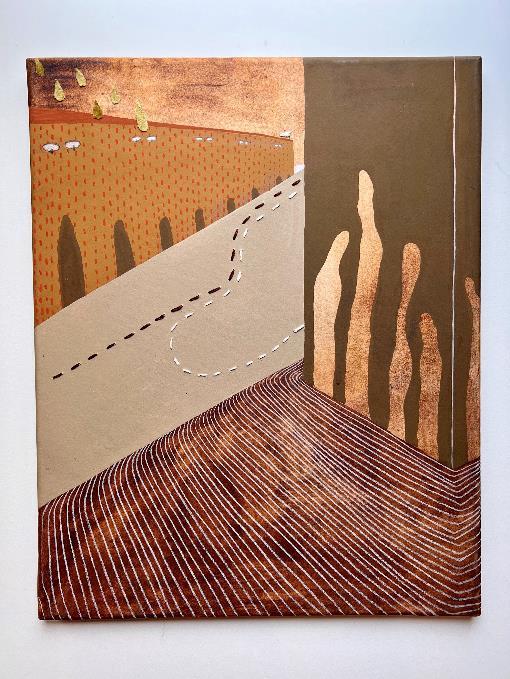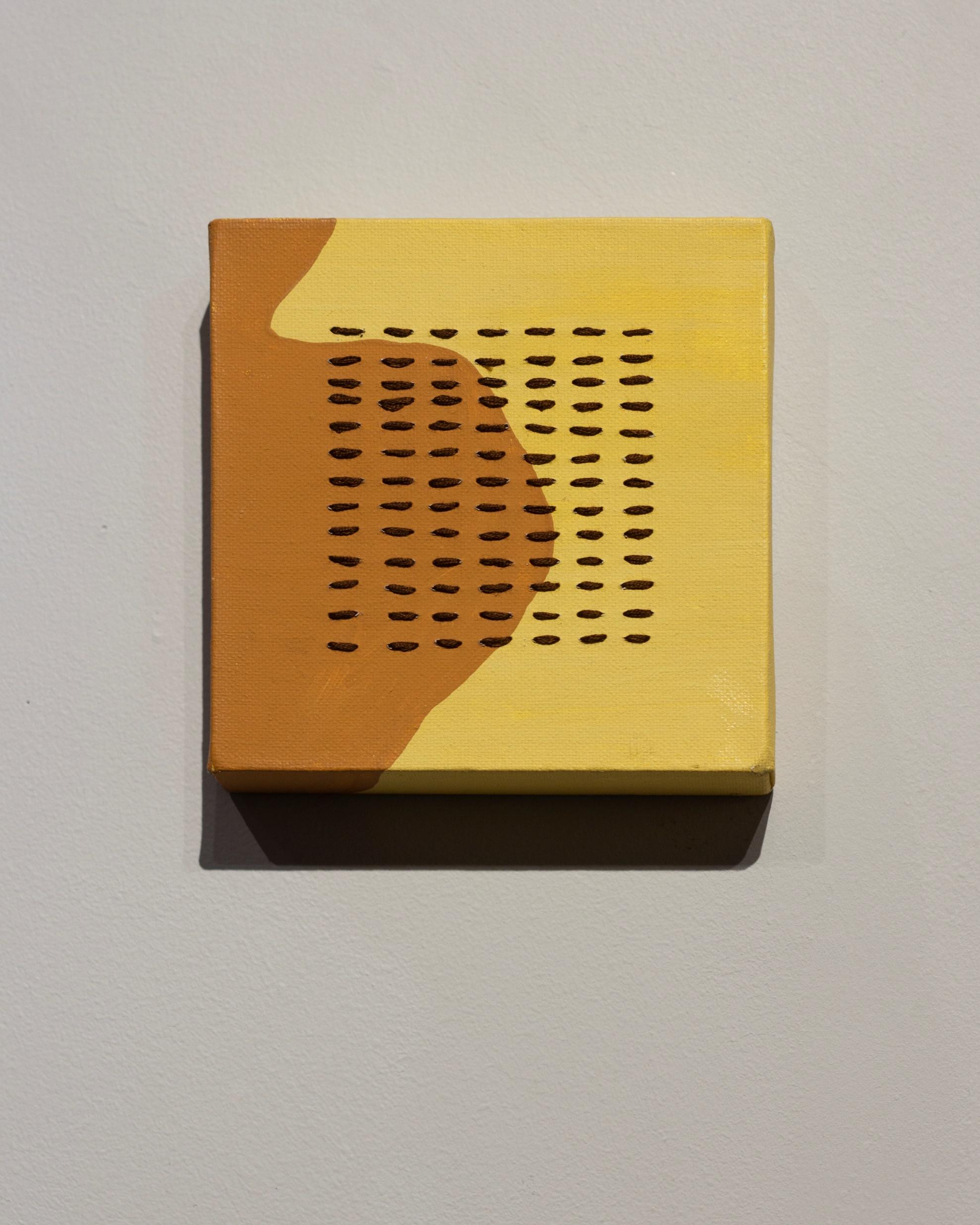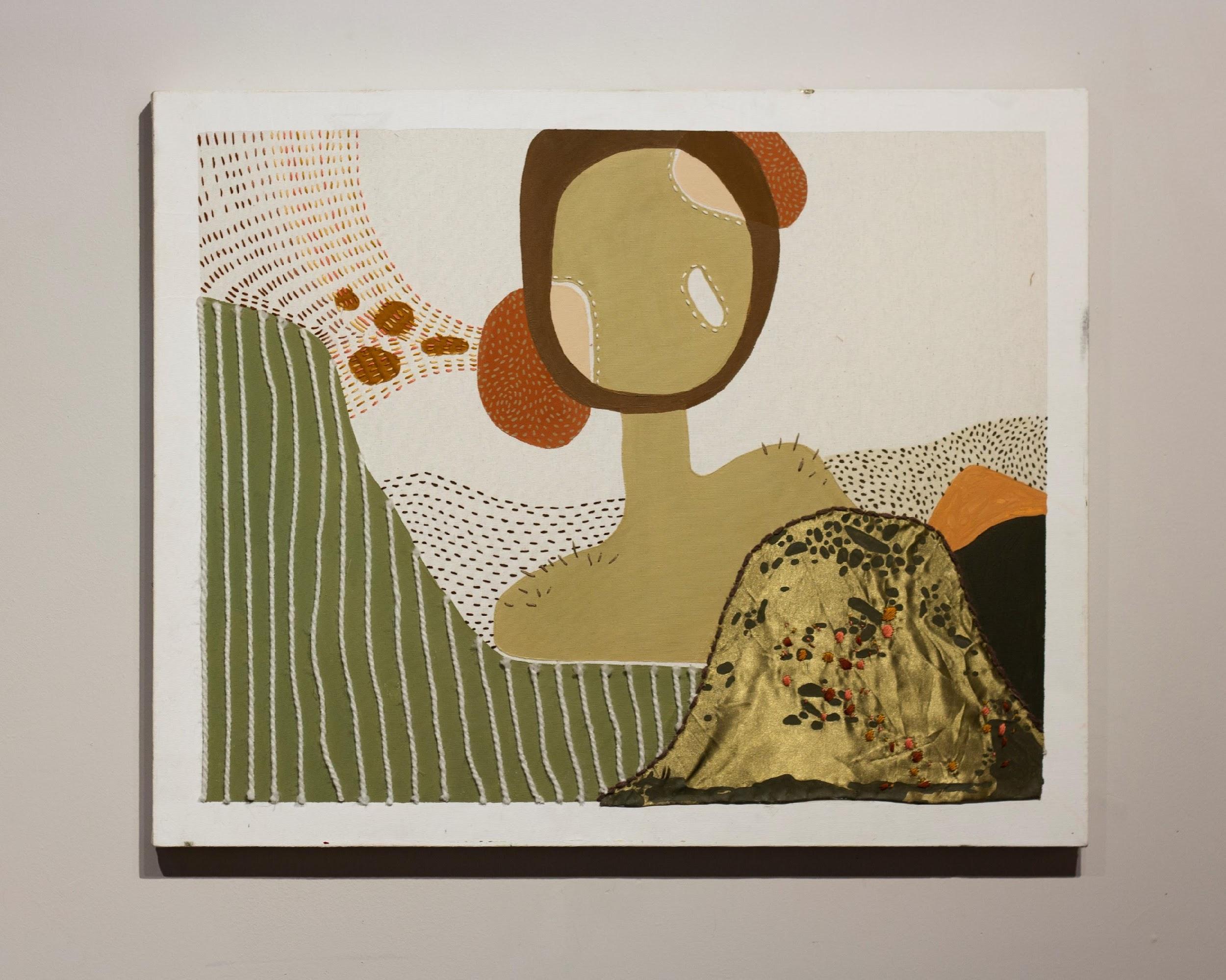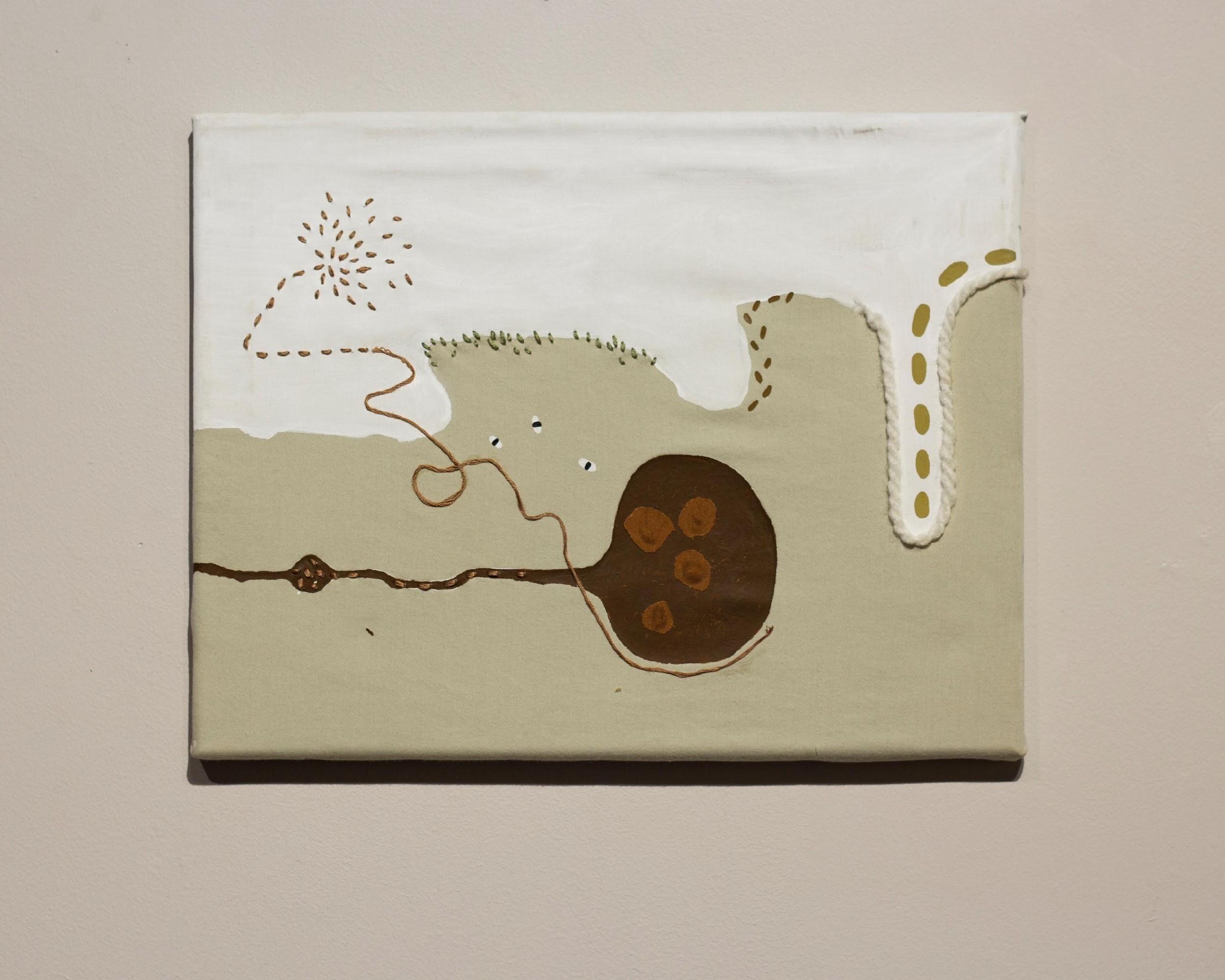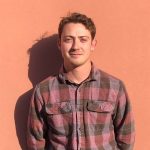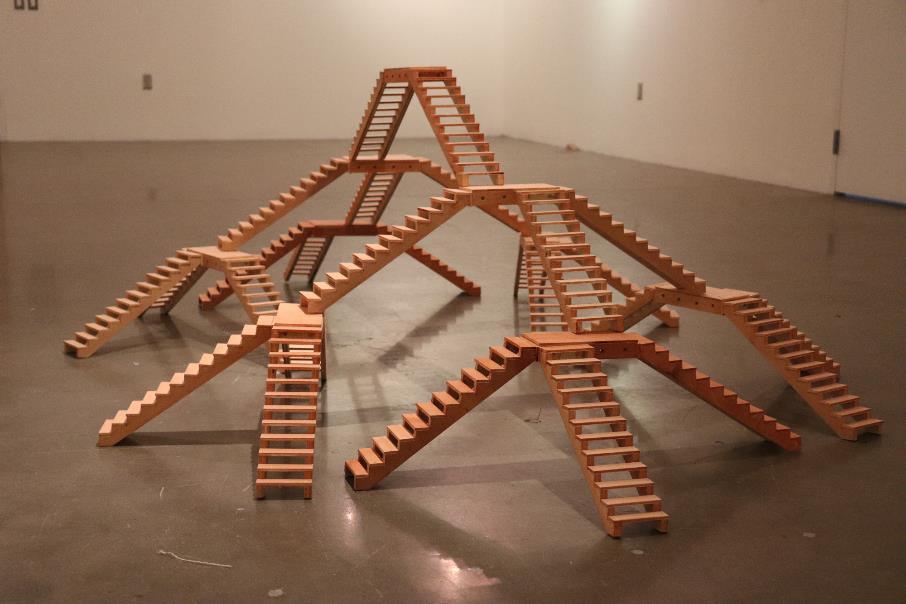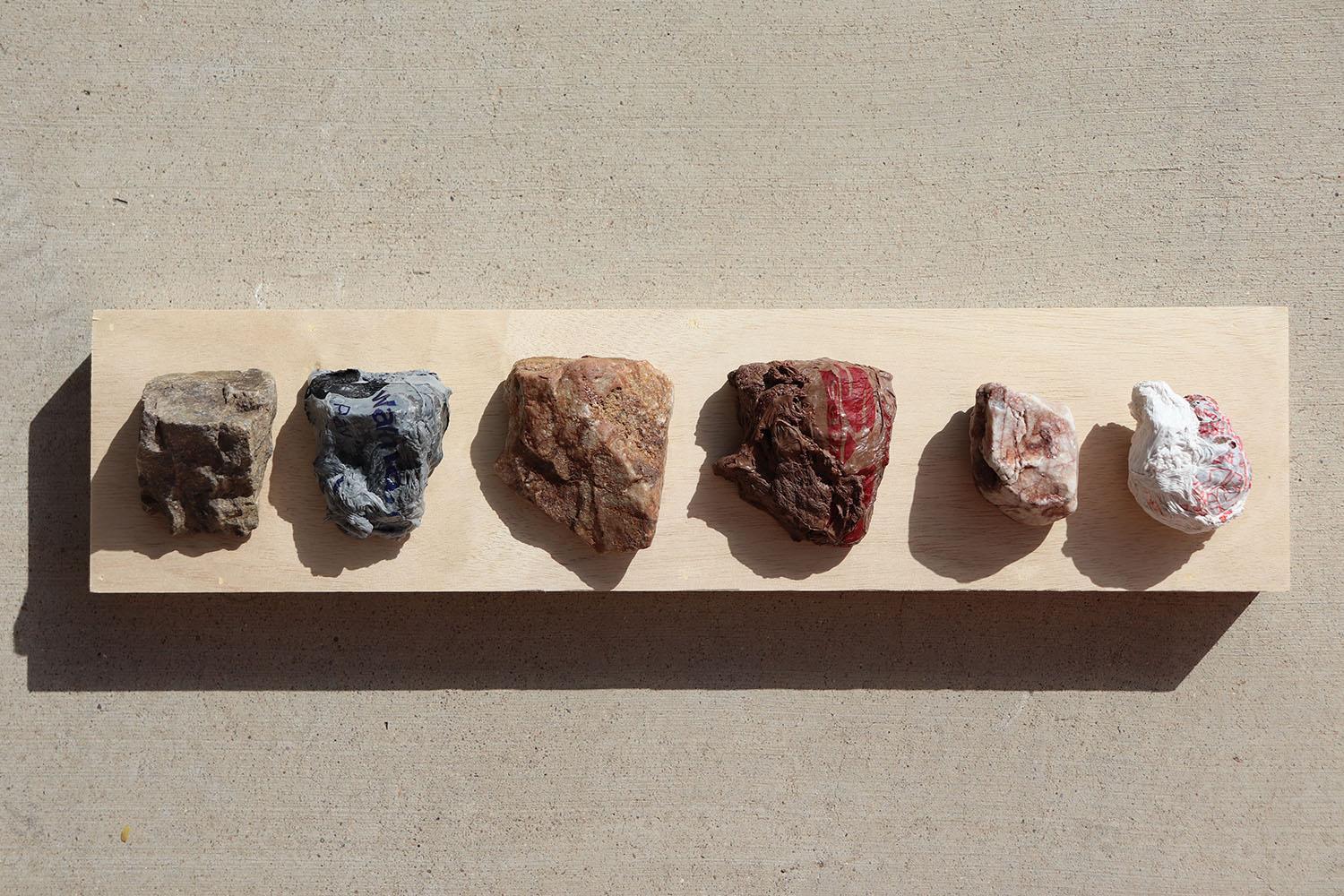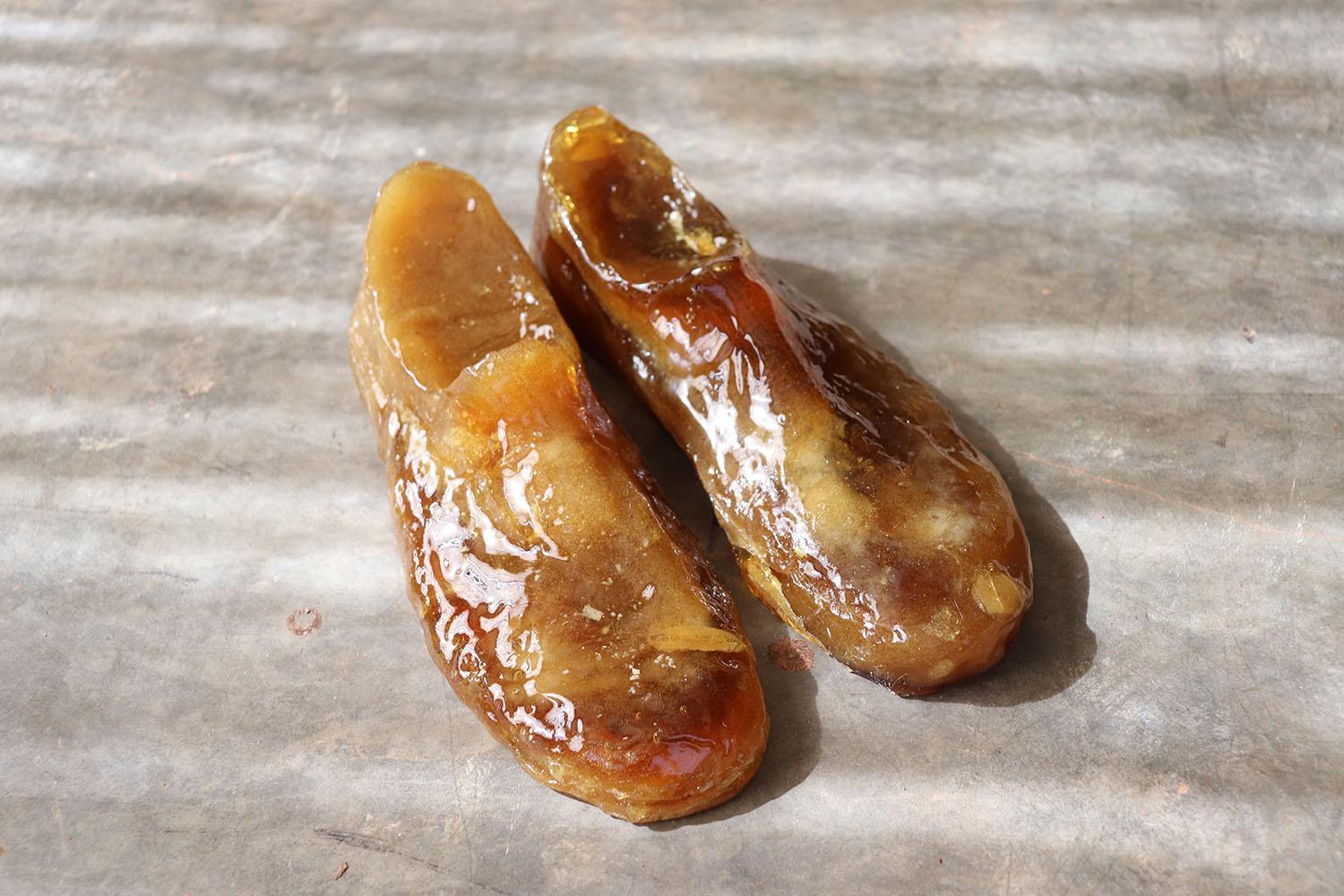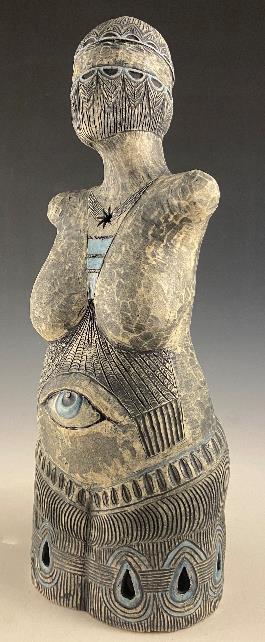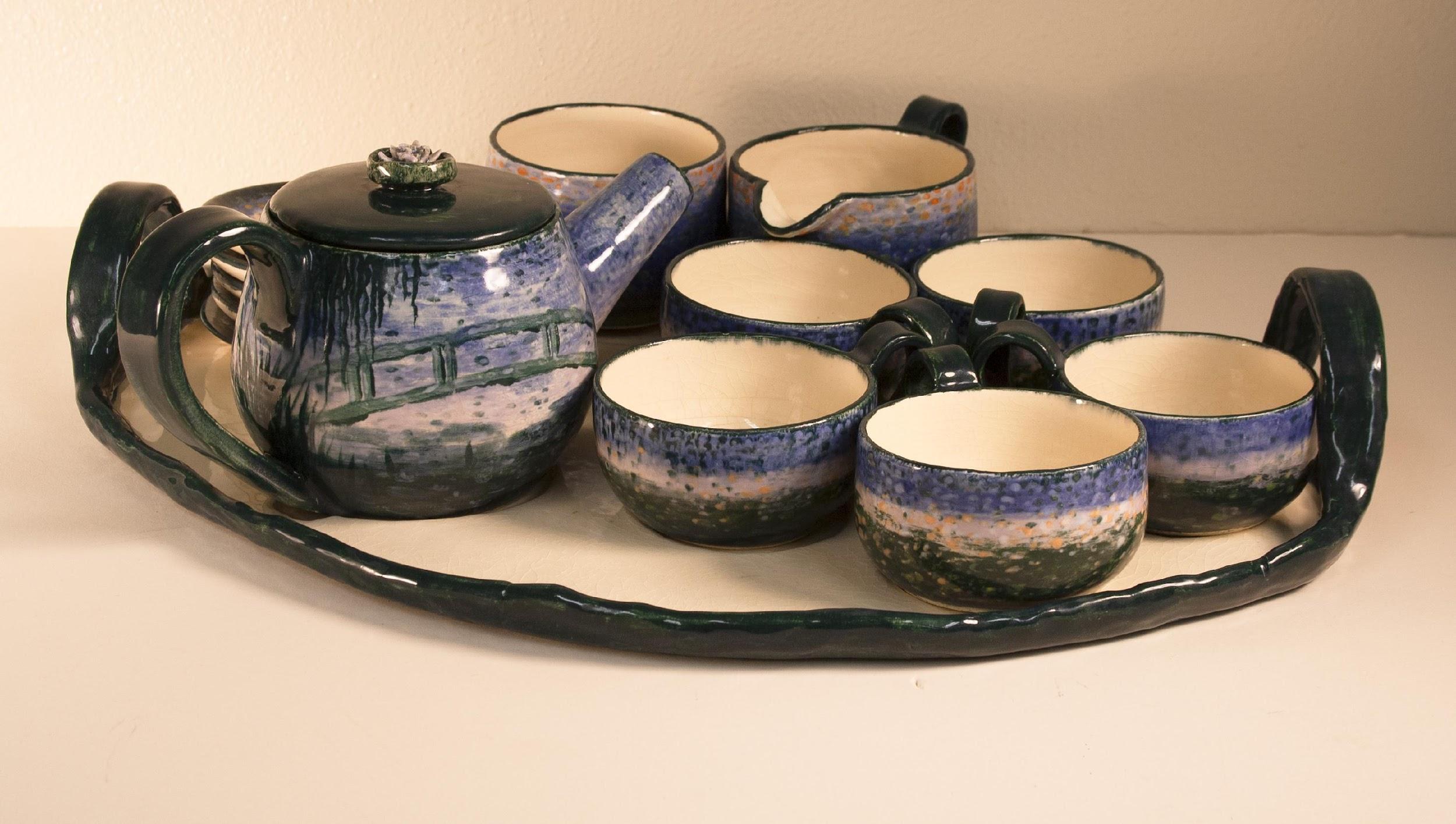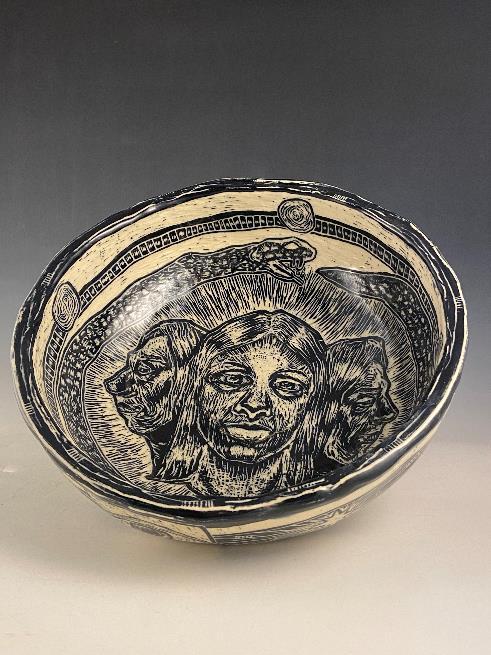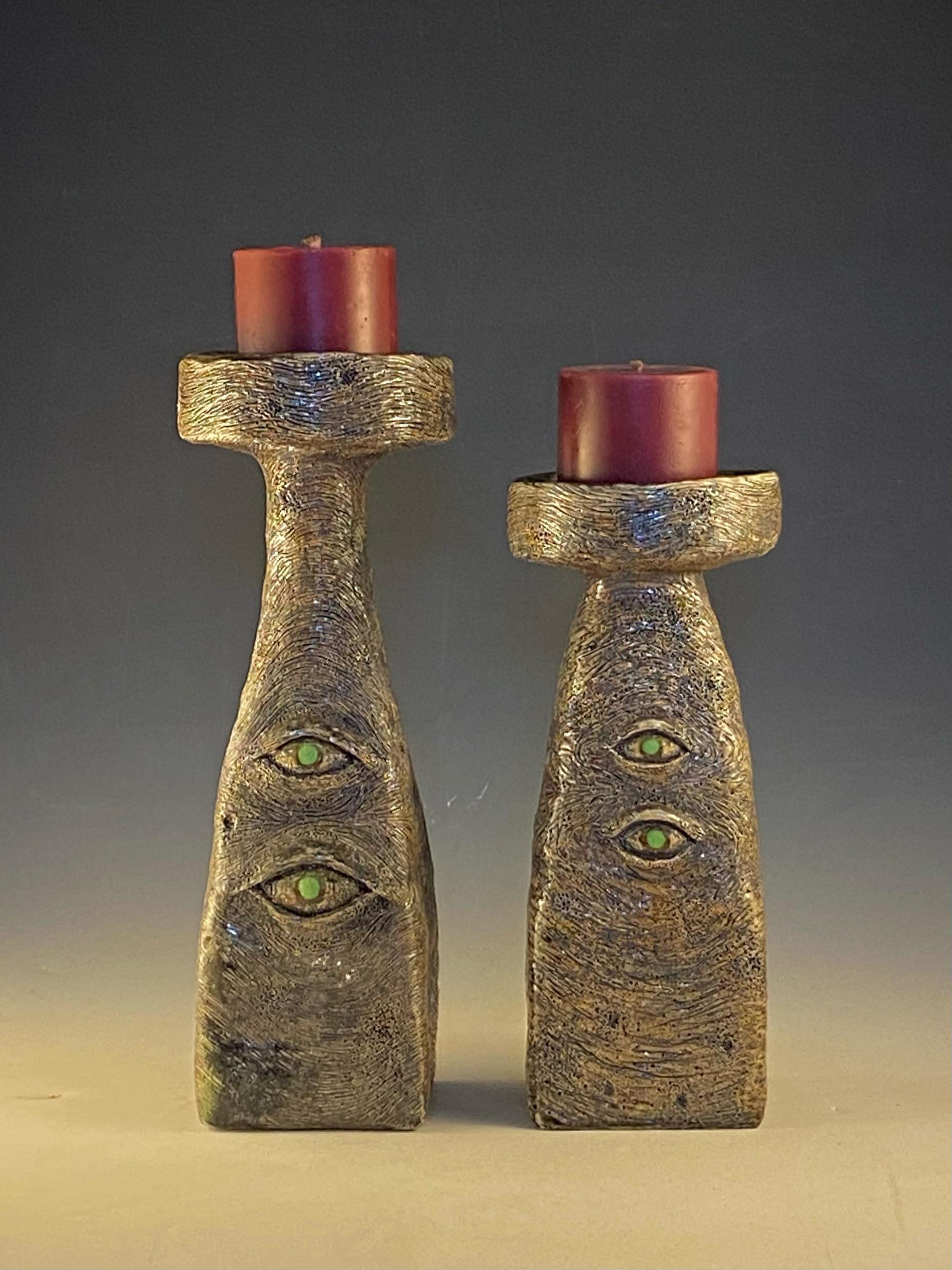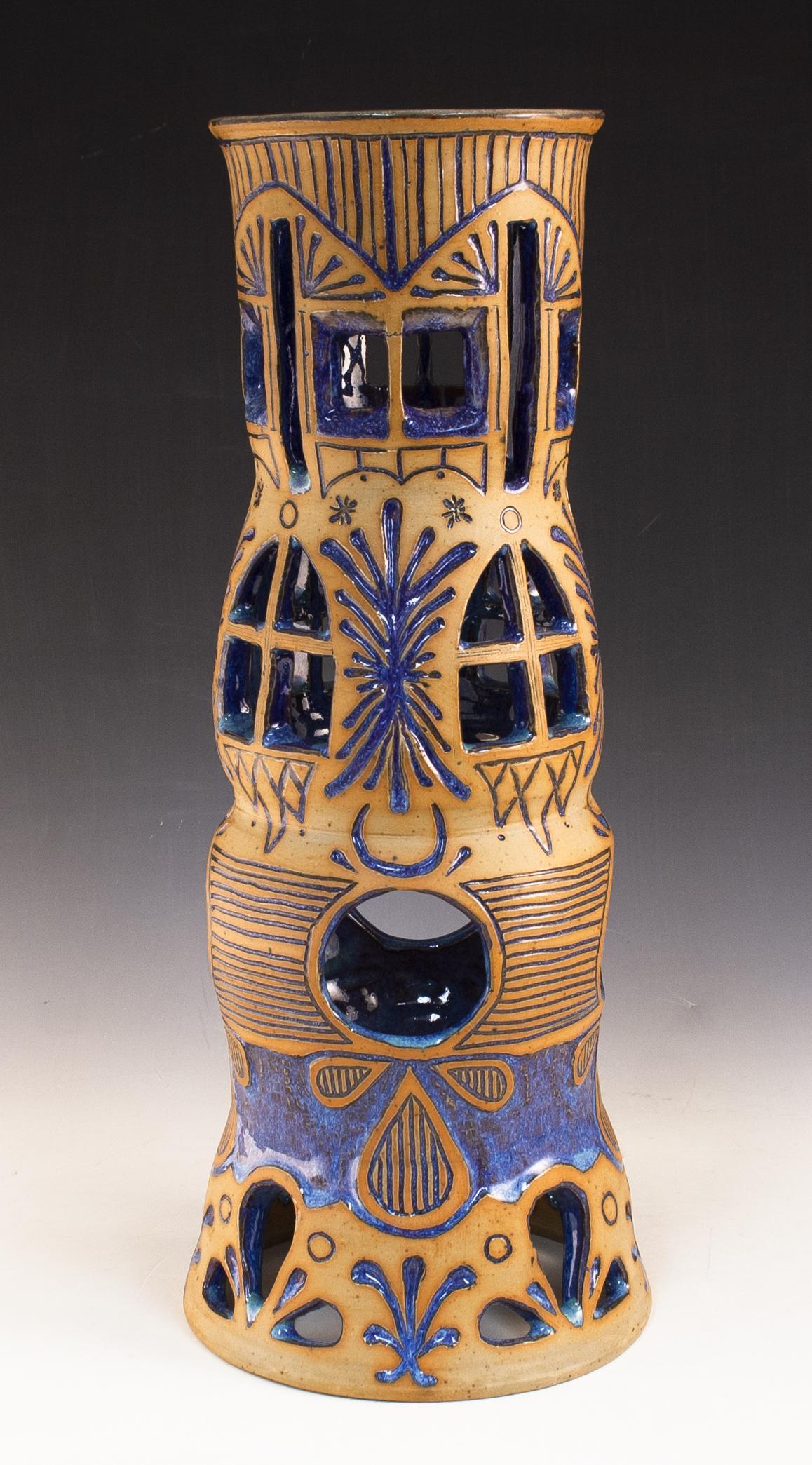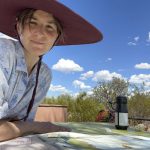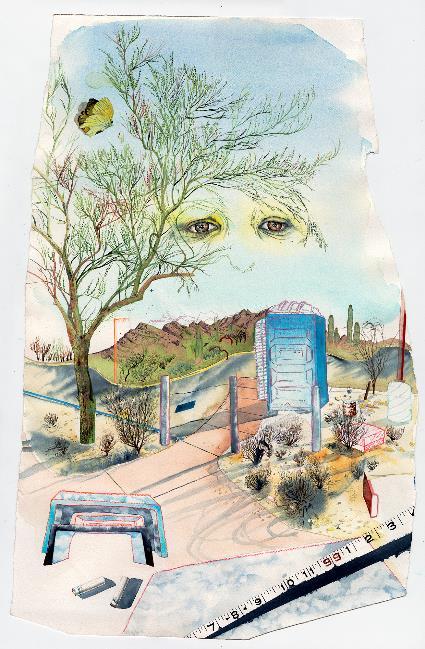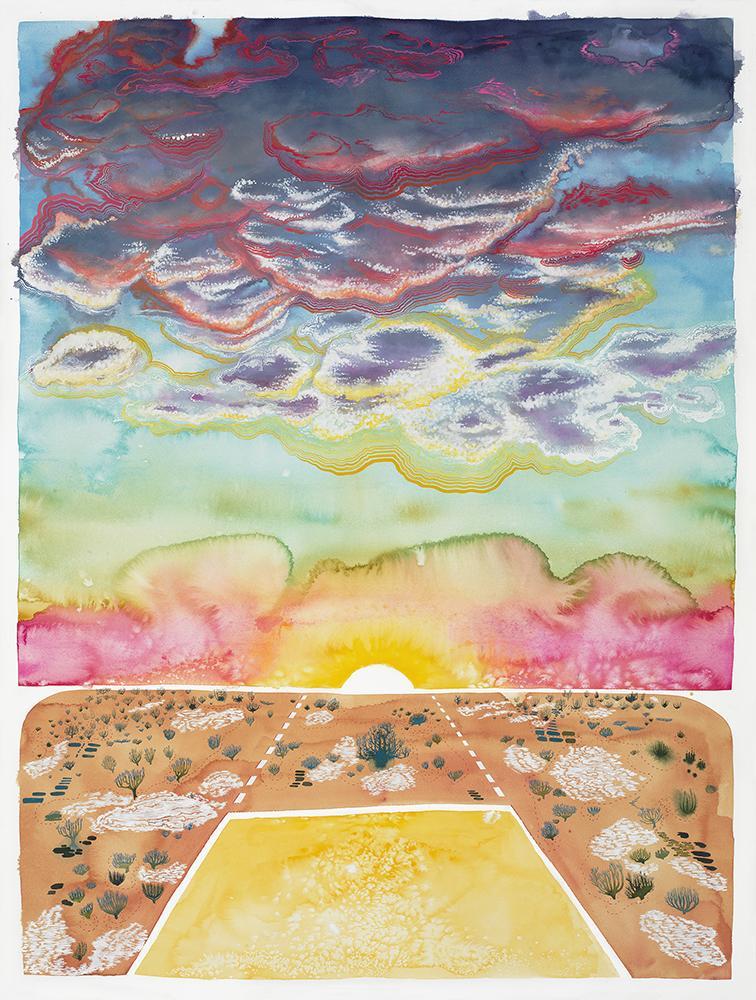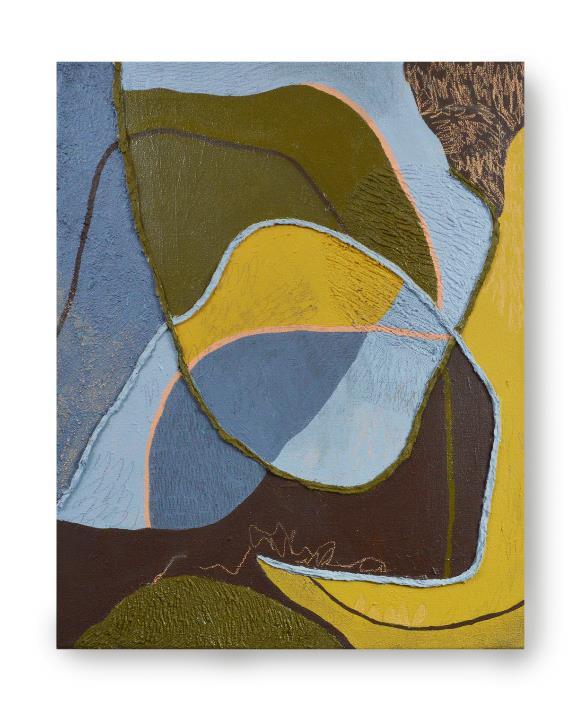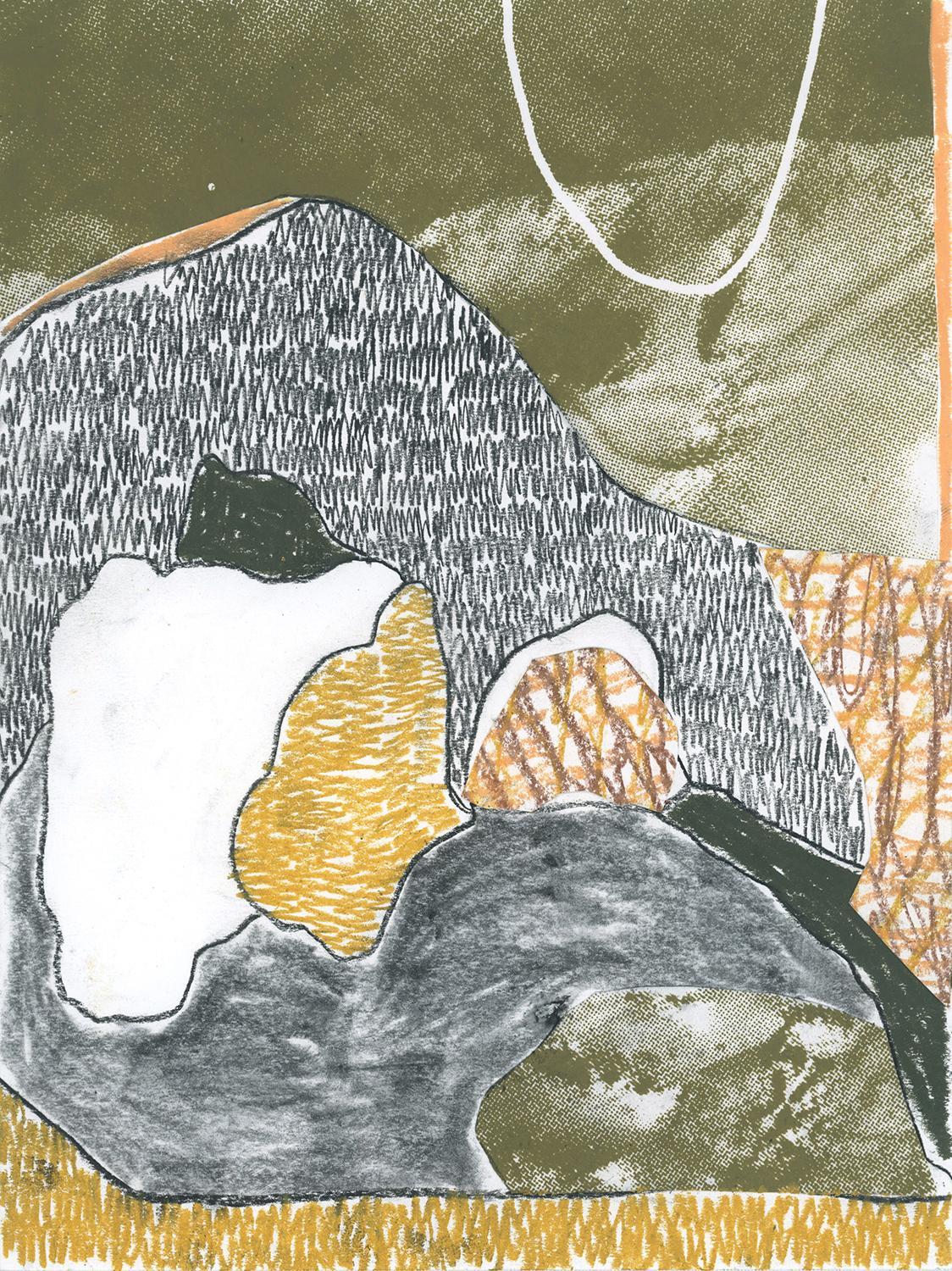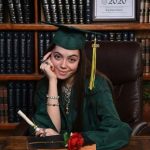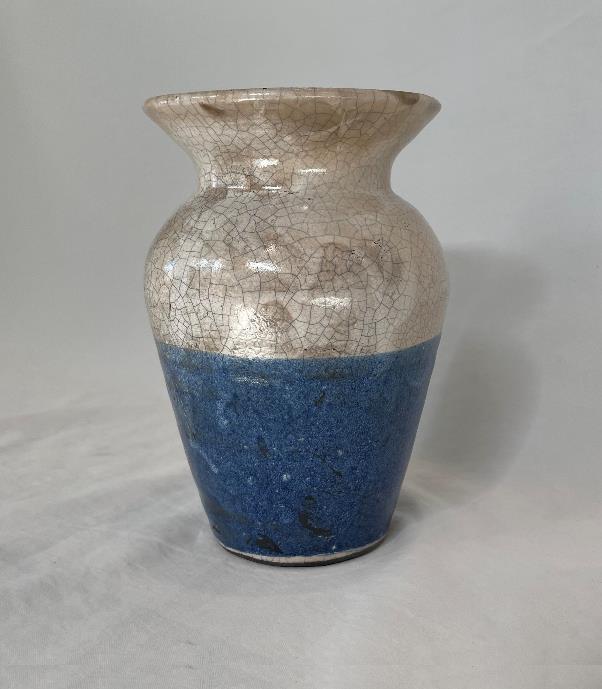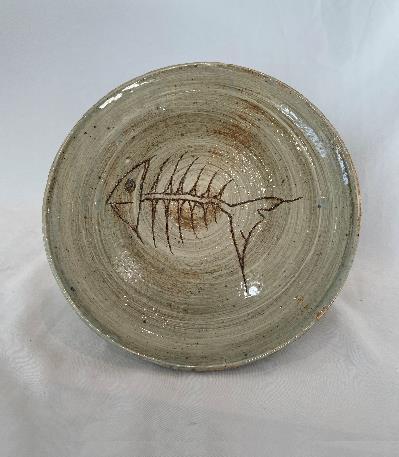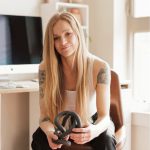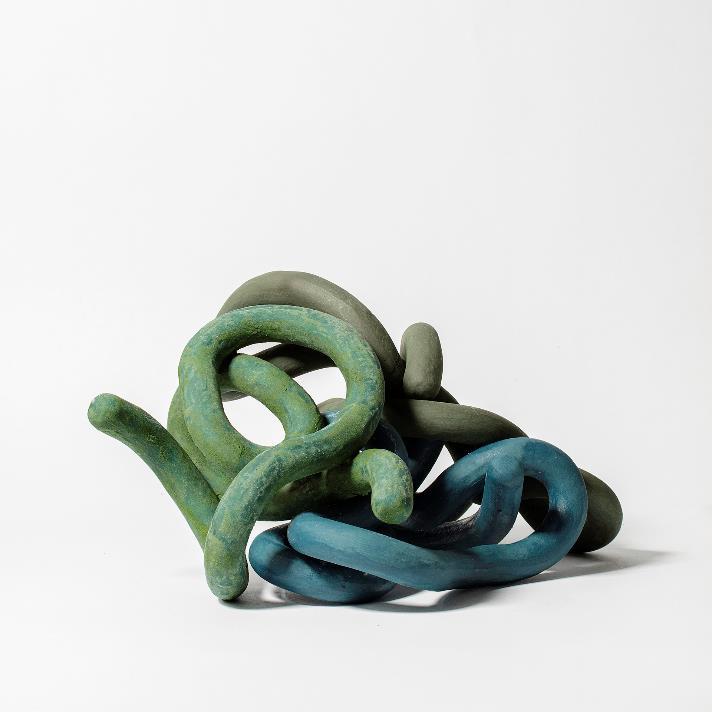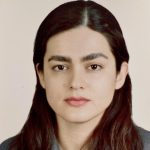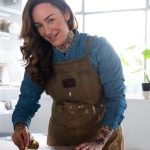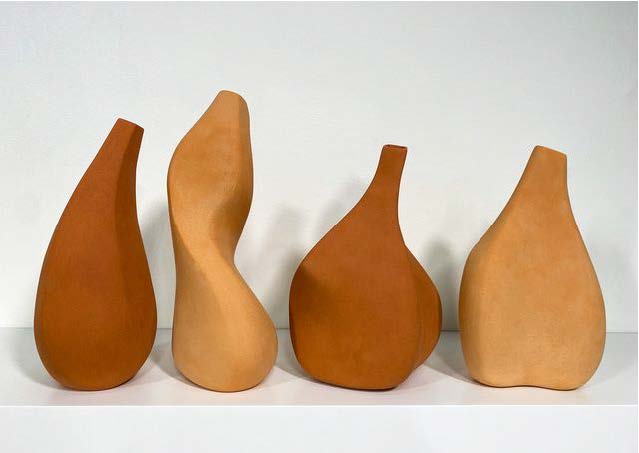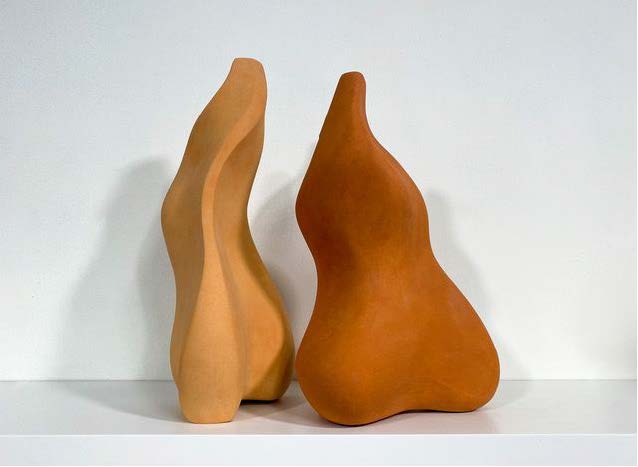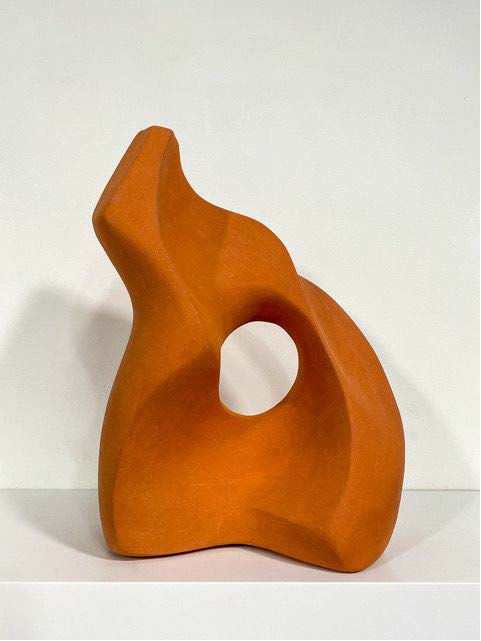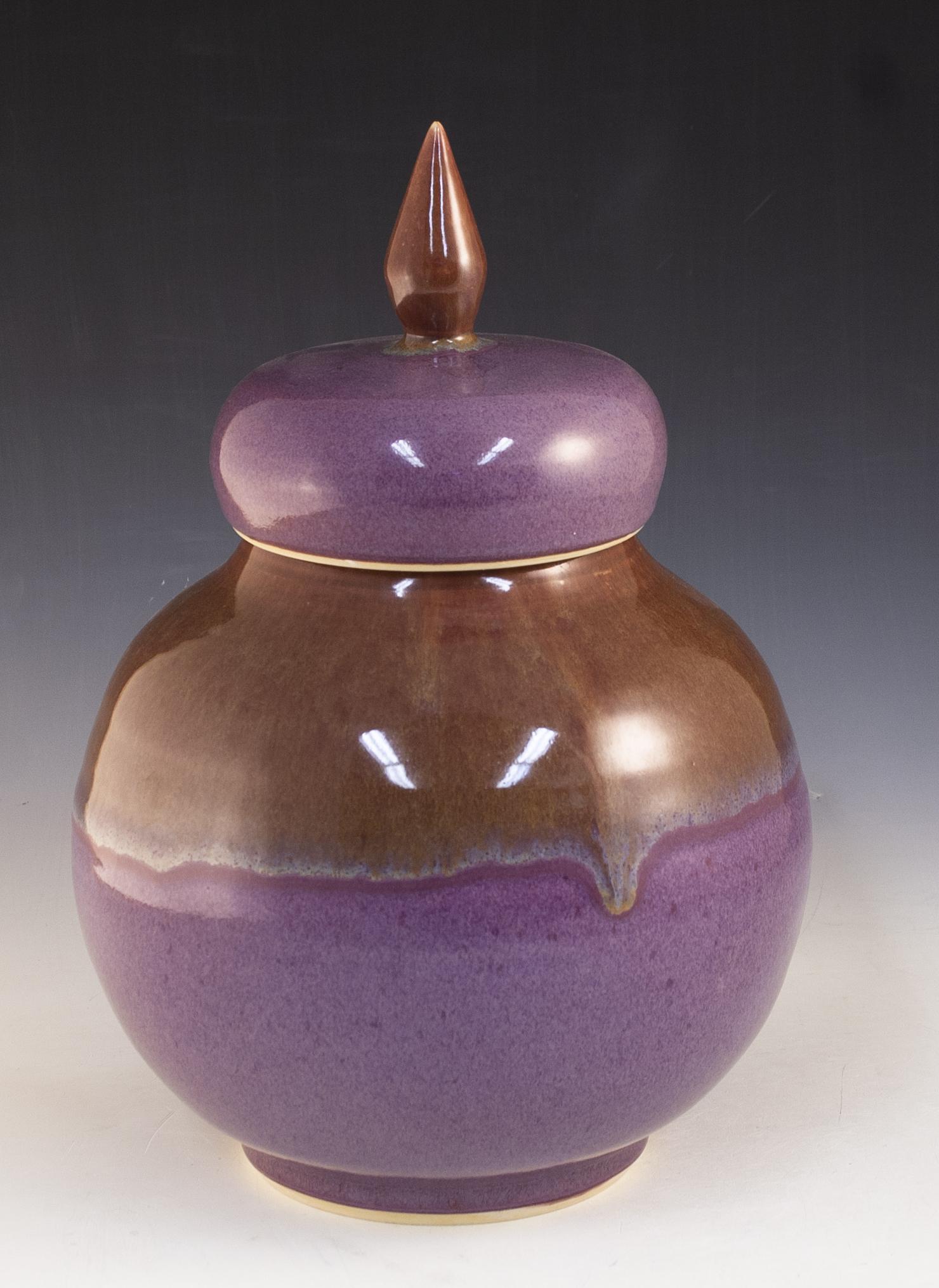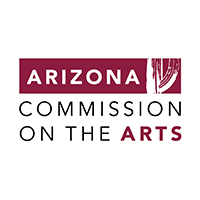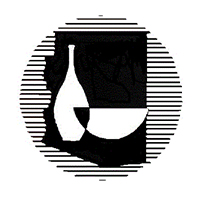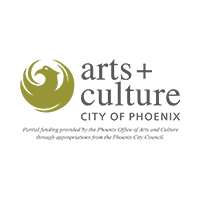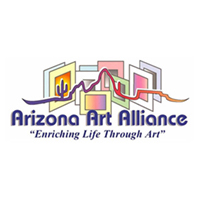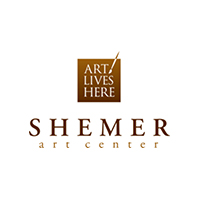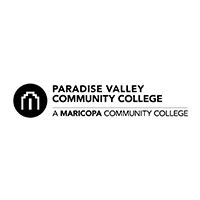2023 SCHOLARSHIP RECIPIENTS
AAG AWA DEL DECIL
Ariana Barley
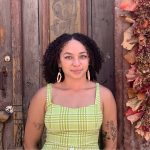
Personal Statement
At the meeting of disdain for history and admiration of land is the location at which my art practice stands. Coming from Alabama, with its humble mountains, red subsoil, and maddening humidity, the land I grew up on has always spoken to me in a voice I still haven’t found a name for. Is it anger, defeat, disapproval? The particular attributes of the ecology of the American south, paired with the unchecked violence of the plantation economies that thrived there, created deep scars in the land. I am interested in investigating histories pertaining to humanity through the lens of ecology and agriculture.
Whose stories does the land hold as it uses their bodies as fertilizer? What has this land seen, this earth under my feet squished into fancy heels, on this plantation on which my white friend has decided to host her wedding? Stories lost to history are held by the land, and these considerations are what led me to make my piece, he Land on Which You Stand. The flattening of form alluding to the human silhouette speaks to the ways the stories and voices of those who labored this land have faded throughout time. I wish to further investigate the humanity held by the land.
Gathering was simultaneously a rumination on the ways in which land has been weaponized against certain bodies, as well as lynchings as a social gathering and spectacle. An aspect of the land as unassuming and beautiful as a tree became a tool for humans to enact violence upon one another in mass gatherings. The ongoing history of lynchings in the United States was brought once again to the forefront of my mind in June 2020, when two black men were found hanging from trees in Southern California, their deaths ultimately ruled as suicides. Utilizing pattern atop washes of watercolor to allude to the repeated, ongoing nature of such violence, Gathering is a piece that calls to mind an aspect of our history that we wish to forget.
he Structures of a Street is a reference to Georgio de Chirico’s painting, Melancholy and Mystery of a Street, in which impending doom looms, with a focus on the street. With structural, systematic oppression and violence in mind, I sought to personify the buildings themselves–these hollow structures which seem to function solely to conceal the violence taking place on the street. I chose to leave the street flat and use only the sewn-in thread to depict the action taking place, urging the viewer to wonder more about the structures of the buildings. How long have they been there? What is their role in this? What’s inside–and is it actually helpful? I ask these questions of many of the structures that guide our society.
In my broader research and studio practice, my interests with regards to water-based media surround the implementation of ecological matter such as soil, plants, and the extraction of dyes and pigments in my works. My current focus is on plants native to Africa which were first introduced to the United States by enslaved people on plantations in the south. Since moving to Arizona, this interest in the ecological voice of place has expanded to include the land, people, and politics of the southwest as well. As I learn more through my research and the fostering of community in this place that is becoming home to me, I seek to gain a deeper understanding of myself and history in relation to the land. I hope
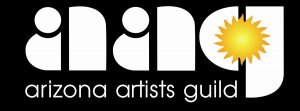 AAG MARIGOLD LINTON
AAG MARIGOLD LINTON
Austin Caswell
Overall, my work stems from a concern surrounding how we as a global population consider our progression, development, and cohabitation with the natural world as we advance into the future. To achieve this, I utilize systems and forms that promote personal, psychological space through the utilization of pathways, particularly stairs. Stairs are significant within this examination as a structure for traveling up or down as well as away from a specific location. In the work provided, the viewer is prompted to engage with their own introspective process of consumption, pace, and established systems they live within while navigating provided structures that prompt lateral eye movement. The aim of prompting lateral eye movement is to recreate similar eye movement one experiences while walking, a prominent time for introspection and mindfulness. I then construct these forms and systems from processed wood products, such as construction grade plywood, hobby wood, or newsprint, to further prompt meditation on how how humans harness, alter, and wield natural materials to suit their needs within a context that must be managed carefully. Woods physical ability to flex and frame space allows it to work as a scaffolding for larger ideas, giving room for the hybridized version of this material to act as a vehicle for personal, psychological space.
To further push the concept of personal, psychological space, I interchange between multiple contexts of thinking through making as well. Shifting between digital as well as analog contexts, my work seeks to explore the current climate we make within. New digital tools allow for more precision and editing; however, they take away a direct component of the human hand in crafting and offer a different system to operate within. In the work presented, each piece was designed digitally, yet was fabricated analogically despite possibilities for it to be fabricated by means of CNC milling, laser cutting, or 3D printing. This shift in thinking and hand further prompts a contemplation from both the maker and the viewer as human error inevitably emerges, confronting the progression of technology, making as a human, and the dilemmas provided from thinking within these two different spaces.
My educational goal through pursuing my Master of Fine Arts is to be the best artist I can be. To help this pursuit, I would like to grow my knowledge in material, technology, and continue to experiment in my practice. Most of all, however, I would deeply value refining and honing my conceptual practice. Conceptual development was the major component as to why I decided to pursue a Master of Fine Arts degree. I deeply respect the space art school offers. Critiques, facilities, fellow classmates who I will know the rest of my life, and deeply knowledgeable faculty who have also made tying art into the world around them their life’s work are all vital components to becoming the most thoughtful and well-rounded artists I can be. I am on a pursuit of being the best artist I can be, and that requires community, communication, vulnerability, giving back, and hard work. Through maintaining these values and continuing my education, I hope to develop into a more thoughtful, intellectually rigorous artist whose work questions and highlights the links between art and the world around us.
AAG AZ CLAY
Belsy Trigueros

Personal Statement
Belsy Trigueros is an Arizona Western College Student who had recently found an interest in Ceramics. She has always had an interest in art but never made the first steps in order to start. Her work is usually made out of what interest her at the time. For example, while creating Lady Venus, Belsy was going through her old World Art text book and found inspirations from the Art piece called Venus of Willendorf. She found this piece and was in awe, she knew that she wanted to create her own interpretation of that Venus. She added related aspects, such as not having a face. To her the piece not having a face gives the Venus a mysterious feel, the Venus isn’t suppose to represent specifically one women but all women. The eye on the Venus’s stomach is suppose to show that while she isn’t able to see where she is going she knows where she will end up eventually, she is all knowing. Waterlillies Teapot was created by Belsy pushing her limits and expanding her knowledge on how to differently glaze. She wanted to try something knew, she wasn’t to familiar with the wheel at the time and kept working to perfect her technique. She eventually was able to reach her goal, the glazing was inspired by Monets Waterlillies. Belsy isn’t to fond of bright colors but she was trying to open new doors, she used skills she had learned in painting courses and slowly made the teapot come to life. This set originally comes with five mugs, five cake plates, one sugar, one creamer, one tea pot and tray. It all comes together by having the similar rounded shape and colors. The Ouroborus Jorum is a representation of a humans life at different stages. Having the Ouroboros reaching for its tail symbolizes that there is a pattern that is being repeated. Putting those together Belsy makes a representation that no matter where in life you are you are still you without breaking the pattern you are staying in the cycle. Belsy’s goals for 2023 is to be admitted to U of A’s School of art or NAU’s school of art, which so far has been a difficult decision. She plans on majoring in Studio Art emphasizing in Sculpture of Ceramic. Belsy’s overall goals is to become a grad student and get a Masters in Studio Art in order to become a Professor and be able to teach courses of what she loves. Belsy has always had excellent relationships with professors which is what inspired her to want to become a Professor. No matter what she is sure that art is going to continue to be a big part of her life whether that means she is able to call herself an artist or a Professor.
AAG AWA DEL DECIL
Claire Taylor
PERSONAL STATEMENT
Cemetery Tree Felled in the Windstorm II is of one of the many trees which fell during the hurricane force windstorm in Salt Lake City in September 2020. This tree remained alive after falling—laying across the Salt Lake City Cemetery road. I’d visit them on my runs. I’d poke my fingers on their needles and take pictures of the trash next to them—thinking the trash held secrets. They were eventually cut. I sat on the ground and painted their likeness—a likeness paired with angel snakes and a purple sky meant to evoke the windstorm.
The painting Snail Snake City was created during my artist residency at the Natural History Museum of Utah, parallel to their special exhibit, “Nature All Around Us,” which was about urban nature. The painting is an ecological memory map of wildlife I have met on my treks in Salt Lake City. I worked on this painting in the main hall of the Natural History Museum while interacting with patrons. I had community art supplies on the table next to me, where I invited patrons to create artwork about their urban wildlife encounters.
Greasewood Park Parking Lot was one of the first paintings I made since moving to Tucson in the fall of 2022. The work depicts a liminal space between what humans perceive and distinguish as nature and human-made, and questions this distinction. The portable restroom is depicted prominently as a way to challenge traditional landscape work in which human-made things are cropped out of the painting. I was intrigued by the color of this restroom as it was like a bright clear sky. Within the painting I made the restroom beautiful as a nod toward thanking the restroom for the service it provides me and other park visitors.
My creative process serves as a way for me to understand and explore existence, the messiness in being human during our current ecological crisis, and my connection to place. My work conveys the intelligence and agency of non-human animals, plants, and abiotic entities of the landscapes I frequent on my runs, walks, and bike rides. I often work en plein air so as to gain an emotional sense of the place and the entities I am depicting.
I am in my first year as an MFA student in Illustration at the University of Arizona. I hold a Master of Science in Environmental Humanities. My former master’s project focused on my encounters with wildlife over the course of a year. My committee, comprised of a biologist, creative writer, and sociologist, provided feedback on my writing; my visual artwork was not critically examined. Since graduating from the Environmental Humanities Graduate Program, I have focused on my art through artist residencies and exhibitions, which are largely self-guided. While I thrive when working in a self-guided manner, I am ready for the artistic evolution provided in an MFA program.
The intention behind my work is to foster empathy for the more-than-human. My artwork reflects my interest in the natural sciences and a desire to understand my ecological network scientifically and psychologically. Given my interdisciplinary interests in both the natural sciences and art, social engagement and communication are often incorporated in my work through collaborations on creative projects informed by environmental advocacy, as well as teaching artist residencies in which I teach youth about ecology through watercolor and book art projects. I would love to continue to perform interdisciplinary collaborations and social engagement based on my artistic pursuits at the University of Arizona. Doing so in a university environment easily allows for collaborations across disciplines.
 AAG MARIGOLD LINTON
AAG MARIGOLD LINTON
Claire Fall Blanchette
Personal Statement
My work examines the preconceived notions of landscape that are determined by personal and global histories, and influence our experience of place in the age of the Anthropocene. I interpret encounters with land that has been curated by man-made interventions such as maps, markers, or monuments. I am interested in how we have dissected the land into parts– designating some for recreation or preservation, and others to be exploited for economic gain.
Important to my process is the collection of rubbings, photographs, and natural objects. The gathered materials serve as historical, emotional, and visual guides, and are transformed to reflect the landscape across different media. Examining space and place in the field echoes my methods of discovery in the studio. Experimentation, process, and the presence of my hand are all important aspects in my work. Using an intuitive method of layering and rubbing, I build drawings, collages, and sculptures. I aim to create something both recognizable and open to interpretive perspectives. This ambiguous duality forces the viewer to walk around, interrogate, and look closely at an object. Through this confrontation, I invite the viewer to contemplate their relationship to these objects, and ultimately, their connection to land.
As I move forward in my artistic career, I aim to create work that critically examines our relationship with the natural world. To navigate conceptual and formal ideas, I consider the work of artists such as Michelle Stuart, Julia Blume, Blane de St. Croix, and writers like Lucy Lippard. These artists are dedicated to a practice that examines landscape through unique and surprising methodologies. I am motivated by their work as I look at our impact on the environment and negotiate my practice within the current ecological times.
Additionally, by pursuing an MFA I am gaining the professional practice skills necessary to make my artistic career sustainable long-term. My experiences teaching, making connections with classmates and professors, and developing a regular studio practice, all contribute to my success outside of an educational setting. I will have the professional skills to set up a studio practice that can be financially maintained through teaching, arts administration, or studio assistantships– allowing me to continue to create work that confronts our fraught relationships with the landscapes we inhabit.
 AAG RUTH MAGADINI
AAG RUTH MAGADINI
Faith Chiaravalloti
ARTIST STATEMENT
I grew up in a big, close-knit, family with love and appreciation for the importance of women. With my Italian heritage, family has always been the first priority. I have always been attached to the artistic scene for as long as I can remember. All of my family members are Artists. Whether it’s physical art, music, theater, or comic books. My mother is a painter and sketch artist, she showed me the importance of feeling through painting.
As an artist, I hope to grow into my aspirations of being a gallery consultant. I hope to learn about the environment of museums and galleries. My love for art and the community is so intertwined and I hope one day I can bring those two aspects of my life completely together in the form of a gallery exhibition.
When I launched my art career in 2019, I had been painting for over six years. I can’t remember a time when I loved anything more than witnessing my emotions take shape as form. I enjoy media such as acrylics, watercolors, markers and pastels and enjoy mixing media. I find painting conducive to representing feelings in an abstract way similar to music, another passion of mine. I have curated playlists that I listen to when I paint. They inform the imagery of my work. I have also grown fond of plaster carving, welding, and iron sculptures.
I tend to organize my art into collections, inspired by particular themes and subjects.
In 2020, I started studying ceramics with David L. Bradley at Paradise Valley Community College. I discovered a love for the tactile quality of clay and the colorful process of glazing. I am inspired by Bradley’s art and dedication to community. With my ceramic sculpture I aspire to express my connections to family and community and to convey love and hope.
“Miku Raku” is a common flower pot that shows the power of raku glaze firing. Showing that even a simple shape can grow its dimension with a bright color and crackle effect. Through this piece I try to convey that humans as a whole are so quick to judge something as “basic” but through further knowledge it may grow to be something so beautiful.
“Fish for Dinner” is a piece of irony. People expect their lives to be full of joy and times of ease. When in reality we are all going through things, just hiding our issues from one another out of embarrassment. The symbol of a dead fish is known for loss, failure, or regret. When it is put on a dinner plate the feelings are shown to everyone at the table. These uncomfortable kinds of feelings can’t always be hidden.
“The Family” is a collection that carries the most personal significance to me. It is inspired by women in my family, similar yet uniquely beautiful. I know a lot of people never get to experience unconditional love from their family or the people around them. I try to share the love that I experience from my family through my art as a means of spreading love and support.
 AAG PRESIDENT
AAG PRESIDENT
Liza Stout
As an artist, I utilize my skill set in ceramics to create thought-provoking work which engages audiences through tactility. My current research connects in material ways the realms of science, ecology, art, and community. My twisted ceramic sculptures are tangled and organic in their form, symbolizing the interconnectedness of human and non-human species. I initially build several curved parts which are then sculpted together to create one entangled piece. The works also represent the complicated structure of the human body’s microbiome and intestinal system. Each individual form is complex enough to stand alone, with different glazes and colors. They can also be combined to create a more complicated form. By encouraging my human audience to move and stack the sculptures, I am giving them power over a materially fragile system. I hope this prompts them to consider the power they wield over ecological systems as well, and how to engage with their natural surroundings cautiously and conscientiously. The forms can be piled in various ways to create a “collective” body of work. This engages the audience through the act of touch to be participants rather than solely viewers.
I’m currently in my first year of graduate school at ASU, in the MFA ceramics department. My goals are to develop my body of creative work and to gain teaching experience in order to pursue a career in higher education. My current research is centered around composting systems and our connection to microorganisms. To me, art is a pathway through which I can combine my practices around composting with at once aesthetic, practical, and conceptual forms. Modern culture tends to cast the rotting process as unappealing, giving it a negative valence that mistakenly conflates rot with waste. My goal is to draw attention to the value of microorganisms through captivating and tactful sculptural forms. The unexpected combination of these practices will open a dialogue around our personal connections to rot.
AAG AWA DEL DECIL
Mehraveh Vahediyan
STATEMENT
The word home is intertwined with many thoughts, feelings and memories. Home is a structure in which the unique aspects of residents’ personalities are imbued with the history, culture and dominant politics in that society. Thus, home and whatever happens within it depict the current reality at both individual and societal levels.
The civilized world is formed not only by physical structures, but also by abstract concepts, systems and values. I examine the home as a smaller and more personal example of the paradigms we create to live in. For me, the idea of home and the feeling of being at home has always been elusive, if we define home as living in the moment, feeling free, accepted, and stable. Thus, my experience of home is quite the opposite of my imagined ideal. In this respect, I am exploring my actual experience of home, rather than presenting an ideal image of it.
In this series of artworks, I explore the concept of home as a place with material presence and a spirituality derived from memories, presences and absences, as well as the objects and complex relationships amongst them. I intend to show that the spaces we live in gradually become repositories beyond buildings that perpetuate personal and cultural traits and maintain their own history. In these artworks, I create interior spaces by assembling all the pieces of information that remind me of home. These pieces do not necessarily come from a particular culture or place; rather, they signify or refer to particular places or times that represent home to me. These spaces do not necessarily make sense logically and often may reference more subtle psychological or poetic sensibilities. Light does not respond to the objects and space, nor is the viewer’s perspective of the scene apparent.
 AAG CURRAN-BLEAKNEY
AAG CURRAN-BLEAKNEY
Nicole Ponsart
Personal Statement
The work selected represents my most recent work and experimentations while living in Arizona and working through themes of memory, sense deprivation, land use, land preservation and landscape.
The first, an unnamed public art installation at Harelson Park in Tempe, Arizona is the product of a public art grant received through the City of Tempe for their Arts in the Park selection of 2022. With input from the local community, I created digital art printed it onto large sheets of 0.030 styrene plastic panels which were then meticulously cut out, fixed in place with eyelets and zip-tied onto a large 500-foot perimeter sport court fence. Each image is double sided and fixed in place through itself onto the fence with the installation being fully visible on either side of the fence. Community input for this installation was essential as it was important for me to execute something which enhanced the public space for the residents and created a strong sense of community identity. There was a strong desire for more visible nature, opportunities for shade during play, pops of color and playful imagery to compliment the adjacent Mariposa Elementary School. The work is currently installed at Harelson Park in Tempe (9325 W Warner Ranch Dr, Tempe, AZ 85284) and will be up until December 2023.
The second selection of work I’m sharing through this application is of a series of work created during the end of the COVID-19 pandemic in Canada. The Arizona & Utah series was created after extensive research on place, geography and geology of places I had never been. Utilizing shapes, curves, lines, tones and textures I wished I could have seen in person during this time, I utilized my time working and learning from home to investigate places which invoked feelings of wonder and adventure. The concept for the work was derived through a desire to visually represent memory and highlight how each person’s lens views the world. With a background in childhood arts education from my life in Canada, it was always intriguing to me to hear how young people recalled information, described the things they saw and attributed fantastical embellishments to their shared stories. I used this as inspiration to create a body of work, fantastical in its presence, to represent canyons and places seen on route to Arizona as if seen through the lens of a child on a road-trip.
The third image created is of an ongoing series which began as a means to test glazes on a sculptural form and catalogue the results. The creation of the suspended bean shaped form eliminated the use of test tiles in my own working studio and allowed for my catalogued tests to become works of art in themselves. The selected image is of an installation of series two which was created using recycled porcelain and fired in experimental soda, salt and wood fire kiln settings. Recently, I’ve received a Jump Start Research Grant through Arizona State University to turn this ongoing concept into a much larger project by utilizing found materials, discarded ceramic materials and recyclable materials to create these forms and have them housed in mesh gabion wall cubes to create outdoor public art forms. Utilizing Cosanti as a site for artistic inspiration, the constructed structures will serve as public art to visually represent how we can utilize recycling and found materials to enhance, preserve and elevate our shared spaces in the desert. When I’m finished my MFA in 2025, my intention is to teach at the university level in ceramics, sustainability, sculpture and public art and use what I learn making this installation as a case study to share with future students.
Sincerely,
Nicole Elizabeth Ponsart
 AAG
AAG
Scott Kamlah
Scott Kamlah AAG Personal Statement
My work draws inspiration from science and nature to create sculpture that provokes reflection and introspection within the viewer. Sometimes this means making a tangible interpretation of a particle so small and ethereal that it evades perception. Other times it involves taking recognizable objects and imagery and imbuing it with some aspect that is alien or meta-normal. In each instance I strive to create objects that bring a fantastical quality into the realm of everyday life.
I’m currently a Master of Fine Arts candidate at Arizona State University and since beginning school here, cast metal has quickly become my preferred medium. A lot of my recent work involves combining traditional foundry techniques with experimental metal casting processes.
While in Graduate School I’ve developed a love of teaching. Presently I’m teaching art 294 Introduction to Foundry and simply love it. After graduation I hope to continue my art practice but also continue teaching what I’ve learned to others. My ultimate goal is to expand the accessibility of cast metal as a medium and share it with as many individuals as possible.
Downpour images 1-2
This sculpture merges cast iron with other metals and materials. Molten Iron was originally poured into a 12-ounce bottle which was then emptied to create a hollow cast iron bottle shape. Later, molten copper was cast into the bottle to create a sculpture which gives the impression that liquid copper is draining out of a suspended iron vessel.
Antler Helix image 3
This sculpture explores natural forms, visual rhythm and repetition. It started with wax copies of lifecast deer antlers. The antlers were sculpted together in layers to create a rising triple helix. The symmetrical helix made from industrial cast iron contrasts with the organic shape of the antler in a way that is both contradictory and complementary.
Vessel and Flame images 4-6
This sculpture is a combination of multiple experimental metal casting processes. Like my sculpture Downpour, it started with molten iron being poured into a glass vessel to make a hollow cast iron bottle infused with glass. I cast iron into the bottle a second time using a casting process that is often referred to as a styrofoam burnout. In this process a styrofoam pattern/shape is buried upside down in silica sand, then molten metal is poured into the bottom to create a perfect replica of the Styrofoam sculpture.
Before casting into the iron vessel a second time, I strategically drilled holes into the bottom and the sides, in which I placed sculpted Styrofoam shapes. I then poured molten iron through the bottom of the bottle so that it flowed through the hollow iron form and into the Styrofoam pieces.
However instead of burying the pattern in sand, I carefully submerged the iron vessel and Styrofoam in a mold made from feed corn and other grains. The organic coral like form is a result of the hot metal burning its way into the negative space between the individual kernels. The resulting sculpture is a unique mix of both controllable and unpredictable elements.
Instead of detail pictures I’ve included two images of the work in progress to help illustrate the process. Image 5 shows the cast iron bottle with the protruding Styrofoam pattern. Image 6 shows the resulting casting after it was moved from the feed corn mold but before it was altered any further.
 AAG ERIN O’DELL
AAG ERIN O’DELL
Cesar Duarte
Personal Statement
The “Copper & Turquoise Moon Jar” is a light stoneware clay body that was thrown on the potter’s wheel to make the traditional Korean Moon jar shape which was then glazed and fired in the process Raku. The Copper & Turquoise Moon Jar was created to show off the characteristics of the firing process of Raku. Enhancing the unique characteristics of the glaze the form has a large body to allow lots of flashing. The “Eroding Textured Bottle” is a high iron stoneware bottle that was wheel thrown and carved. The bottle was carved to allow for glaze to be inlaid within the texture, while the edges were unglazed to show the bare clay to allow the texture to pop & create an eroding effect. The “Eroding Textured Bottle” was then fired in a Soda kiln to allow for more flashing through the application of soda spray during the firing. The “Tarnished Gold Bottle” is a light stoneware body that was wheel thrown vessel that was inspired by Edo Period bottles with its wide shoulder and small opening. The “Tarnished Gold Bottle” was then Soda fired raw to allow for the Soda mixture to give the vase the firing’s orange peel effect especially along the shoulder. The “Tarnished Gold Bottle” was made to emphasize the effects of raw soda, the process that forms the island like pooling along the shoulder.
My end goal would be becoming a Ceramic Professor to keep sharing the life and joy of clay. To show others that the arts can be a stable job without the stereotype of the broke artist. My goal would be to achieve my masters in fine arts with the emphasis of ceramics to continue learning as no one ever stops learning in the arts. I find it greatly important to be willing to learn no matter how experienced you may be.
